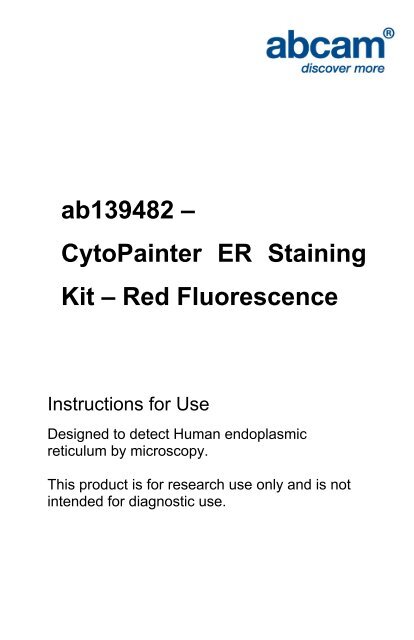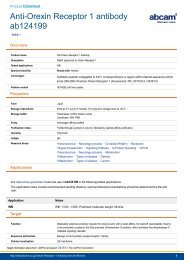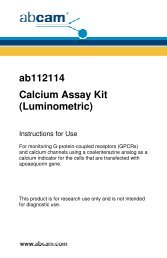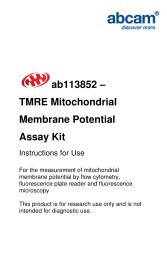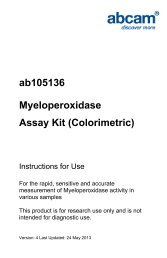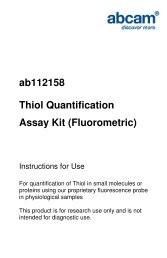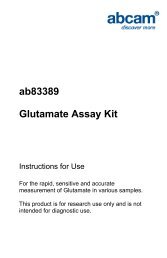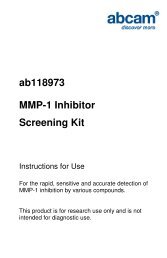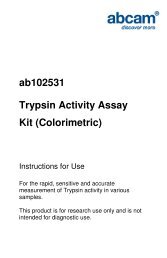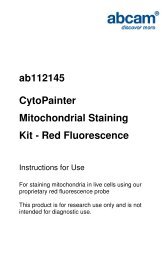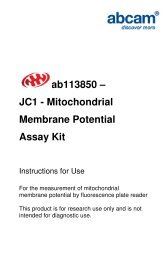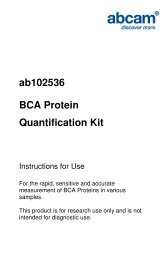ab139482 â CytoPainter ER Staining Kit â Red Fluorescence - Abcam
ab139482 â CytoPainter ER Staining Kit â Red Fluorescence - Abcam
ab139482 â CytoPainter ER Staining Kit â Red Fluorescence - Abcam
You also want an ePaper? Increase the reach of your titles
YUMPU automatically turns print PDFs into web optimized ePapers that Google loves.
Table of Contents1. Introduction 32. Product Overview 43. Assay Summary 54. Components and Storage 65. Pre-Assay Preparation 76. Assay Protocol 97. Data Analysis 138. Troubleshooting 152
1. Introduction<strong>Fluorescence</strong> co-localization imaging with green fluorescent protein(GFP)-tagged proteins is a powerful approach for determining thetargeting of molecules to intracellular compartments and forscreening of their associations and interactions. However, to date,photoconversion of red fluorescent dyes to green fluorescent onesand metachromatic artifacts, wherein fluorescent dyes emit both inthe red and green regions of the spectrum, have led to spuriousresults in GFP co-localization experiments. Additionally, manyorganelle targeting probes photobleach rapidly, are subject toquenching upon concentration in organelles, are highly toxic, or onlytransiently associate with the target organelle, requiring imagingwithin a minute or two of dye addition.Consequently, <strong>Red</strong> Detection Reagent, a new red-emitting, cellpermeablesmall molecule organic probe that spontaneouslylocalizes to live or fixed endoplasmic reticula, was developed. The<strong>CytoPainter</strong> <strong>ER</strong> <strong>Staining</strong> kit can be readily used in combination withother common UV and visible light excitable organic fluorescent dyesand various fluorescent proteins in multicolour imaging and detectionapplications. The dye emits in the Texas <strong>Red</strong> region of the visiblelight spectrum, and is highly resistant to photobleaching,concentration quenching and photoconversion.3
2. Product Overview<strong>ab139482</strong> contains a novel endoplasmic reticulum-selective dyesuitable for live cell, or detergent-permeabilized aldehyde-fixed cellstaining. Micromolar concentrations of <strong>Red</strong> dye are sufficient forstaining mammalian cells, as validated with human cervicalcarcinoma cell line, human T-lymphocyte cell line, Jurkat, HeLa andhuman bone osteosarcoma epithelial cell line, U2OS.<strong>ab139482</strong> is specifically designed for use with GFP-expressing celllines, as well as cells expressing blue, cyan or yellow fluorescentproteins (BFPs, CFPs, YFPs). Additionally, the kit is suitable for usewith live or post-fixed cells in conjunction with probes, such aslabeled antibodies, or other fluorescent conjugates displaying similarspectral properties as fluorescein, or coumarin. A nuclearcounterstain is provided to highlight this organelle as well.4
3. Assay SummaryThaw components, prepare reagents; warm to room temperaturePrepare cellsAdd Dual Detection Reagent for 15-30 minutes at 37°CWash cells in Assay BufferAnalyze stained cells by wide-field fluorescence or confocalmicroscopy5
4. Components and StorageA. <strong>Kit</strong> ContentsItem Quantity Storage Temperature<strong>Red</strong> DetectionReagentHoechst 33342Nuclear Stain50 µL ≤ -20°C50 µL ≤ -20°C10X Assay Buffer 15 mL ≤ -20°CReagents provided in the kit are sufficient for approximately 500microscopy assays using either live, adherent cells or cells insuspension.B. Storage and HandlingUpon receipt, the kit should be stored upright at ≤-20°C,protected from light. Avoid repeated freezing and thawing.C. Additional Materials Required Standard fluorescence microscope. Calibrated, adjustable precision pipets, preferably withdisposable plastic tips. Adjustable speed centrifuge with swinging buckets (forsuspension cultures). Glass microscope slides. Glass cover slips (18 x 18 mm).6
Deionized water. Anhydrous DMSO (optional). Growth medium (e.g. Dulbecco’s Modified Eagle medium, D-MEM). Paraformaldehyde (optional, for fixation). Triton X-100 (optional, for permeabilization).5. Pre-Assay PreparationNOTE: Allow all reagents to thaw at room temperature beforestarting with the procedures. Upon thawing, gently hand-mix orvortex the reagents prior to use to ensure a homogenous solution.Briefly centrifuge the vials at the time of first use, as well as for allsubsequent uses, to gather the contents at the bottom of the tube.A. Reagent Preparation1. 1X Assay BufferAllow the 10X Assay Buffer to warm to room temperature.Make sure that the reagent is free of any crystallizationbefore dilution. Prepare enough 1X Assay Buffer for thenumber of samples to be assayed by diluting each milliliter(mL) of the 10X Assay Buffer with 9 mL of deionized water.7
2. 3.7% Formaldehyde SolutionThe following procedure is for preparation of 10 mL of 3.7%formaldehyde solution. Dilute 0.37 gram paraformaldehydeto a final volume of 10 mL with 1X Assay Buffer. Mix well.3. 0.1% Triton X-100 (optional)The following procedure is for preparation of 10 mL of 1%Triton X-100 solution: Dilute 10 µL Triton X-100 to a finalvolume of 10 mL with 1X Assay Buffer or 1X Assay Buffercontaining 2% serum. Mix well.4. Dual Detection ReagentThe concentration of <strong>Red</strong> Detection Reagent for optimalstaining will vary depending upon the application.Suggestions are provided to use as guidelines, throughsome modifications may be required depending upon theparticular cell type employed and other factors such as thepermeability of the dye to the cells or tissues. To reducepotential artifacts from overloading of the cells, theconcentration of the dye should be kept as low as possible.Prepare a sufficient amount of Detection Agent for the number ofsamples to be assayed as follows: For every milliliter of 1X AssayBuffer (see preparation in step 1) or 1X Assay Buffer containing 2%serum, add 1 µL of <strong>Red</strong> Detection Reagent and 1 µL of Hoechst33342 Nuclear Stain.8
NOTE:a) The dyes may be combined into one staining solution oreach may be used separately, if desired.b) The Hoechst 33342 Nuclear Stain can be diluted further if itsstaining intensity is much stronger than the greenendoplasmic reticulum stain, Green Detection Reagent.c) When staining BFP- or CFP-expressing cells, the Hoechst33342 Nuclear Stain should be omitted due to its spectraloverlap with these fluorescent proteins.6. Assay ProtocolA. <strong>Staining</strong> Live, Adherent Cells1. Grow cells on 18 x 18 mm coverslips, or tissue culturetreated slides, inside a Petri dish filled with the appropriateculture medium. When the cells have reached the desiredlevel of confluence, carefully remove the medium.2. Dispense a sufficient volume of <strong>Red</strong> Detection Reagent(Section 4A) to cover the monolayer of cells (around 100µLof labelling solution foe cells grown on an 18 x18 mmcoverslip).3. Protect samples from light and incubate for 15-30 minutes at37˚C.4. Wash the cells with 100 μL 1X Assay Solution. Removeexcess buffer and place coverslip on slide.9
5. Analyze the stained cells by wide-field fluorescence orconfocal microscopy (60X magnification recommended).Use a standard Rhodamine or Texas <strong>Red</strong> filter set forimaging the endoplasmic reticulum. Optionally, image thenucleus using a DAPI filter set and the GFP-tagged proteinusing a GFP/FITC filter set.B. <strong>Staining</strong> Live Cells Grown in Suspension1. Centrifuge cells for 5 minutes at 400 x g at room temperature(RT) to obtain a cell pellet.2. Carefully remove the supernatant by aspiration anddispense sufficient volume of Dual Detection Reagent (seeSection 4A) to cover the dispersed cell pellet.3. Protect samples from light and incubate for 15-30 minutes at37°C.4. (Optional) Wash the cells with 100 μL 1X Assay Buffer.Remove excess buffer. Resuspend cells in 100 μL 1X AssayBuffer, then apply the cells to a glass slide and overlay witha coverslip.5. Analyze the stained cells by wide-field fluorescence orconfocal microscopy (60X magnification recommended).Use a standard Rhodamine or Texas <strong>Red</strong> filter set forimaging the endoplasmic reticulum. Optionally, image thenucleus using a DAPI filter set and the GFP/FITC proteinfilter set.10
C. <strong>Staining</strong> of Aldehyde-Fixed and Detergent-PermeabilizedLive Cells with <strong>Red</strong> Detection ReagentThe <strong>Red</strong> Detection Reagent is capable of staining fixed andpermeabilized cells. Fixation and permeabilization makes itpossible to probe for other intracellular structures byconventional immunofluorescence labeling methods.1. Wash the cells in 1x Assay Buffer (from Section 4A).2. Carefully remove the buffer covering the cells, and replace itwith freshly prepared 3.7% formaldehyde solution.3. Incubate the cells at 37°C for 10 minutes.4. After fixation, rinse the cells several times in 1X AssayBuffer.5. (Optional) If cells are to be labeled with an antibody,permeabilization step is recommended to enhance theantigen’s accessibility. This is done by incubating the fixedcells in 0.1% Triton X-100 (Section 4A) at room temperaturefor 1 minute.6. Following permeabilization, rinse the cells with 1X AssayBuffer.7. Perform staining as recommended for adherent orsuspension cells.NOTE: When performing standard immunofluorescence stainingprotocols using a Texas <strong>Red</strong>-, Rhodamine-, or Coumarin-labeledantibodies, or equivalent, administer post-fixation according tomanufacturer instructions.11
D. Aldehyde Fixation and Detergent permeabilization ofStained Live CellsLive cells stained with <strong>Red</strong> Detection Reagent may be fixed withformaldehyde and permeabilized with Triton X-100. Fixation andpermeabilization makes it possible to probe for other intracellularstructures by conventional immunofluorescence labelingmethods. The <strong>Red</strong> Detection Reagent dye is retained followingfixation and permeabilization using the protocol described below.1. Wash the <strong>Red</strong>-stained cells with 1x Assay Buffer (Section4A).2. Carefully remove the buffer covering the cells, and replace itwith freshly prepared 3.7% formaldehyde solution.3. Incubate the cells at 37°C for 10 minutes.4. After fixation, rinse the cells several times in 1X AssayBuffer.5. (Optional) If the cells are to be labeled with an antibody,permeabilization step is recommended to enhance theantigen’s accessibility. This is done by incubating the fixedcells in 0.1% Triton X- 100 (from Section 4A) at roomtemperature for 1 minute.NOTE: The staining will not be as intense after fixation of cells. It isrecommended to fix prior to staining cells.12
7. Data AnalysisFilter set selectionThe selection of optimal filter sets for a fluorescence microscopyapplication requires matching the optical filter specifications to thespectral characteristics of the dyes employed in the analysis. Consultthe microscope or filter set manufacturer for assistance in selectingoptimal filter sets for your microscope.Figure 1. <strong>Fluorescence</strong> excitation and emission spectra for <strong>Red</strong> dye(panel A) and absorbance and fluorescent emission spectra forHoechst 33342 dye (panel B). All spectra were determined in 1XAssay Buffer.13
Endoplasmic reticula are subcellular organelles found in eukaryoticcells, responsible for sorting most of the proteins and lipids of thecell. In addition to being a live cell-permeable dye, <strong>Red</strong> dye is alsopartially retained during or after cell fixation and detergentpermeabilization.<strong>Red</strong> dye has been shown to co-localize with EGFP-calreticulinchimeric protein in a transduced HeLa cell line. Typically, intense redfluorescent staining of the endoplasmic reticulum in the perinuclearregion of mammalian cells is readily apparent using <strong>Red</strong> dye. The<strong>Red</strong> dye co-localizes with the EGFP-calreticulin signal,demonstrating selectivity for endoplasmic reticula.14
8. TroubleshootingProblem Reason SolutionEndoplasmicreticula are notsufficiently stained.Precipitate is seenin the 10X AssayBufferBlue nuclearcounterstain istoo brightcompared to thered endoplasmicreticulum stain.Very lowconcentration of<strong>Red</strong> dye was usedor dye was incubatedwith the cells for aninsufficient length oftime.Precipitate forms atlow temperatures.Differentmicroscopes,cameras and filtersmay make somesignals appearvery bright.Either increase thelabellingconcentration orincrease the timeallowed for the dyeto accumulate in theendoplasmic reticula.Allow solution towarm to roomtemperature or 37°C,then vortex todissolve allprecipitate.<strong>Red</strong>uce theconcentrationof the nuclearcounterstain orshorten the exposuretime.15
Cells do not appearhealthySome cells requireserum to remainhealthy.Add serum to stainand wash solutions.Serum does not affectstaining. Normalamounts of serumadded range from 2%to 10%.16
UK, EU and ROWEmail: technical@abcam.comTel: +44 (0)1223 696000www.abcam.comUS, Canada and Latin AmericaEmail: us.technical@abcam.comTel: 888-77-ABCAM (22226)www.abcam.comChina and Asia PacificEmail: hk.technical@abcam.comTel: 108008523689 ( 中 國 聯 通 )www.abcam.cnJapanEmail: technical@abcam.co.jpTel: +81-(0)3-6231-0940www.abcam.co.jpCopyright © 2012 <strong>Abcam</strong>, All Rights Reserved. The <strong>Abcam</strong> logo is a registered trademark.All information / detail is correct at time of going to print.19


